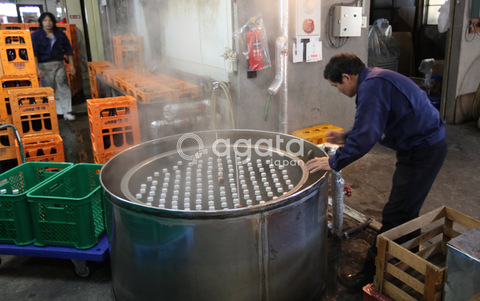The 8 traditional sake brewing processes in Japan
Some people may have wondered how sake is made and what the traditional sake brewing process is like. In this article, we will present the detailed stages and method of making sake.
The information is provided by experts working at the Yoshida Shuzo sake factory in Shimane Prefecture.
Japanese sake is made according to Japanese taste standards. Sake is created by the skilled hands of master sake brewers and is not influenced by any culture.
The sake brewing technique and process in Japan is considered unique in the world, with no other country having preceded it.
In Japan, there are two types of rice: regular rice used for cooking and Sakamai rice (larger and softer grains, grown only in certain areas with a more complicated cultivation technique). The latter is used for brewing sake.
Rice Milling (Seimai)
The process of milling the rice (Seimai) is an important step in the sake brewing process. During this step, the outer layers of the rice are removed to expose the core, which is called the "shinpaku". This process helps to produce sake with a cleaner, purer flavor and aroma. The amount of milling can vary, but typically the rice is milled to 50-60% of its original size. The process of milling the rice is carefully controlled to ensure the right amount of milling and to prevent the rice from breaking. After milling, the rice is washed and soaked in water to prepare it for the next steps in the brewing process.

The milling rate is one of the most important factors in determining the quality and flavor of premium Japanese sakes such as Honjozo, Junmai, and others. The milling rate, or the percentage of the rice that is milled away, affects the flavor and aroma of the sake as well as its body and texture. A higher milling rate typically results in a sake with a more full-bodied, rich flavor, while a lower milling rate produces a lighter, more delicate sake. In general, premium sakes such as Junmai have a higher milling rate, while sakes like Honjozo have a lower milling rate. However, the milling rate is just one of many factors that contribute to the flavor and quality of sake, and the overall taste of a sake also depends on factors such as the type of rice used, the brewing method, and the water source.
Washing, Soaking, and Cooking Rice into Rice Porridge
After the rice has been polished, the sake brewers start the process of washing, soaking, and cooking the rice into rice porridge. The entire process of washing, soaking, and cooking the rice takes around one day to ensure the perfection of the koji-making ingredients.

Raising mold (Koji) - Essential in the sake brewing process
It is the most important process in the sake brewing steps. At the start, the workers sprinkle Koji mold on the rice and leave it for about 48 hours (2 days), where the starch is broken down and converted into sugar. Controlling the temperature is crucial as the flavor of the Sake is determined during this stage.

The process of Koji making for sake brewing is mandatory and must be performed in a controlled room with high temperature and appropriate humidity called Koji Muro. The growth of the Koji mold and the temperature are monitored and adjusted every 3 to 4 hours to ensure the quality and flavor of the sake.
Mixing Stage (Moto)
The Koji, yeast, rice, and water are mixed together. The mixture transforms into sake through yeast fermentation and the quickest yeast fermentation takes at least four weeks.
Adding Ingredients Stage (Moromi)
Koji, white rice, and water are added to the mixture during the next four days after the mixing stage (Moto). The yeast fermentation process takes about a month.
Pressing the Sake
At the end of the yeast fermentation process, the sake is pressed and divided into Seishu (clear, pure sake) and Sakekasu (sake with yeast sediment).
Filtering the Sake
The sake is filtered through prepared starch. However, currently, many producers retain the natural flavor, uniqueness, and individuality of the Japanese sake by skipping the sake filtering process.
Aging Sake

Before aging, sake undergoes a process called Hiire to kill bacteria, mold and unnecessary elements and then is placed in the aging barrel.
Once these processes are completed, the manufacturer will then taste, bottle, and distribute high-quality, delicious Sake bottles to sake lovers.
Reference the price list of some exclusive high-end sake lines distributed at agataJapan:
| Brand | Price |
Sake Kimoto Junmai Ginjo Maruto 720ml |
695.000₫ |
Sake Dewatsuru Junmai Daiginjo Hitennoyume 720ml |
780.000₫ |
Sake Dewatsuru Sakura Emaki 360ml |
415.000₫ |
Tango Shichihime Junmai Ginjo |
765.000₫ |
Yosamusume Umeshu |
695.000₫ |
